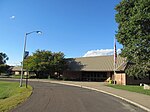Hatfield (CDP), Massachusetts
Census-designated places in Hampshire County, MassachusettsCensus-designated places in MassachusettsSpringfield metropolitan area, MassachusettsUse mdy dates from July 2023

Hatfield is a census-designated place (CDP) comprising the main village in the town of Hatfield in Hampshire County, Massachusetts, United States. The population of the CDP was 1,318 at the 2010 census, out of a total town population of 3,279. It is part of the Springfield, Massachusetts Metropolitan Statistical Area.
Excerpt from the Wikipedia article Hatfield (CDP), Massachusetts (License: CC BY-SA 3.0, Authors, Images).Hatfield (CDP), Massachusetts
Prospect Street,
Geographical coordinates (GPS) Address Nearby Places Show on map
Geographical coordinates (GPS)
| Latitude | Longitude |
|---|---|
| N 42.369722222222 ° | E -72.605555555556 ° |
Address
Prospect Street 24
01038
Massachusetts, United States
Open on Google Maps








